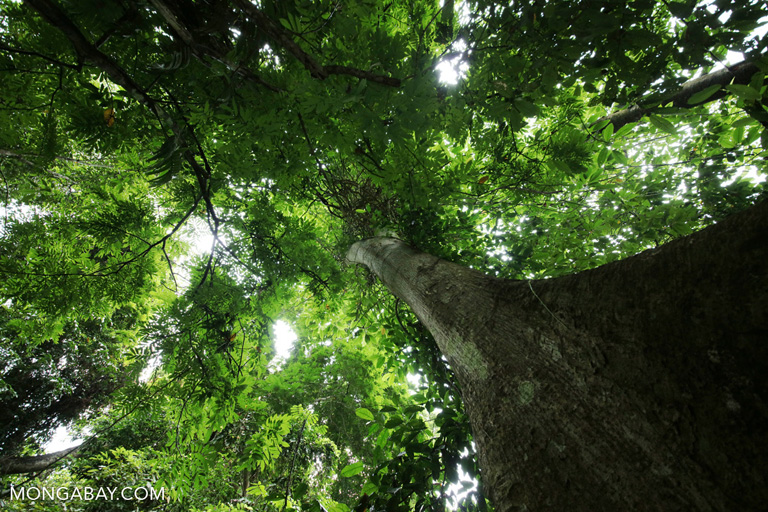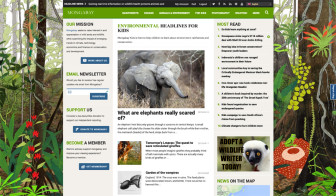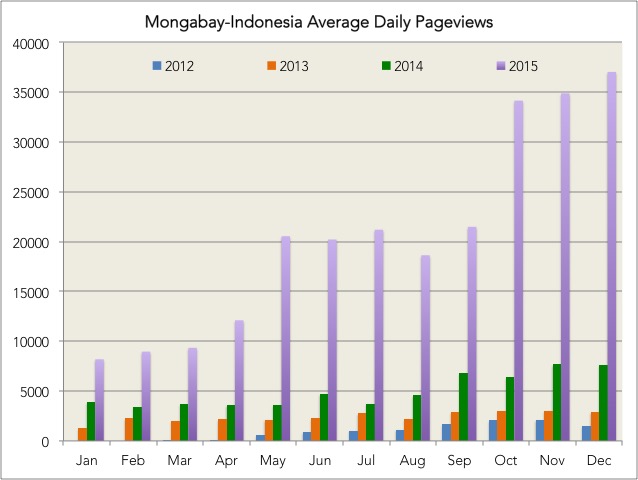
2015 was a monumental year for Mongabay in terms of the organization’s growth, reach, and impact.
Here are some brief highlights from 2015:
MONGABAY
- Mongabay has been completely redesigned — you can see the new site at mongabay.com.
- Our full-time global team has grown from 4 to 11 since the beginning of the year, including an editor for our Spanish-language initiative – Mongabay Latin-America – which will formally launch in early 2016. By the end of next year, we hope to have daily Spanish news reporting in a dozen countries in Central and South America.
- Our global network of journalists has grown from 12 at this time last year to more than 70. Our translator network involves more than 100 people.
- We've launched several new reporting initiatives, including palm oil, endangered environmentalists, Indonesian community forests, Latin American wildlife trafficking, Indonesian haze beat, and "almost famous", a series of little-known charismatic species.
- Traffic to Mongabay’s environmental content amounted to 10.5 million unique visitors, 14.5 million visits, and 24 million pageviews in 2015. The reach of this content was extended via social media and third party sites that republished our stories.
- Dozens of stories produced under our reporting program have been published by third party outlets including The New York Times, ScientificAmerican, TakePart, Deutsche Welle, and The Guardian, among others.
- We've launched wildtech.mongabay.com, a new initiative that looks at how technology can be better leveraged to support conservation, including monitoring, law enforcement, and anti-poaching.
- We produced nearly 1,300 stories in English, almost 300 in Spanish, over 80 in both Portuguese and French, more than 40 in Italian, Chinese, and German; and more than 25 in Japanese.
- Tropical Conservation Science published more than 70 peer-reviewed papers and saw its impact factor rise to 1.329 from 1.092.
- Our kids section on rainforests averaged 150,000 visits a month. We launched early childhood e-readers for iPads and established a news section for kids.
- Mongabay reporting sparked an investigation into a cacao plantation in Peru, a crackdown on poaching in Sumatra’s Leuser Ecosystem by the Ministry of Forestry and Environment, raids against illegal loggers operating in South Sumatra’s Sembilang National Park, and interest from a major studio in producing a documentary series on “endangered environmentalists.” Mongabay stories also catalyzed broader reporting by mainstream media outlets.
- Nearly 18,000 new staff photos were added to the site.

MONGABAY-INDONESIA
- Mongabay-Indonesia’s team grew from five to six full-time staff, while our contributor network across nearly three dozen cities and towns expanded to 40.
- Readership grew over 300 percent to 7.5 million pageviews and 3.8 million unique visitors.
- Top ministers publicly referenced Mongabay-Indonesia on several occasions.
- A Mongabay-Indonesia story covering of an illegal shipment of birds from the Moluccas sparked an investigation by the Ministry of Environment and Forestry.
- After reading Mongabay-Indonesia’s story on encroachment and illegal logging in Sembilang National Park, the governor of South Sumatra ordered a crackdown on logging.
- The head of Indonesia’s Ministry of Environment and Forestry ordered the Head of Leuser National Park to take action against poaching after she read a Mongabay-Indonesia article on the topic.
We have big ambitions for 2016. If you'd like to help, this is our donate page.

